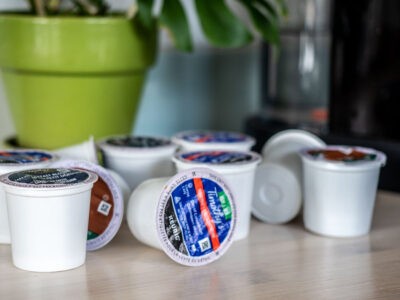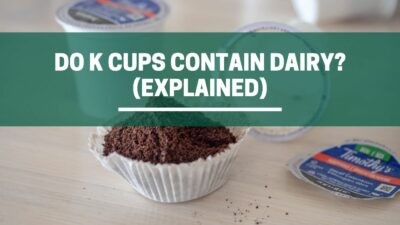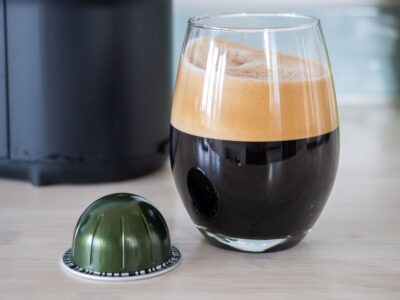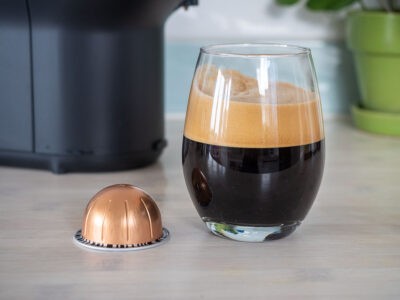Descaling Guides
How To Descale An Electric Kettle (The Right Way!)
Regularly descaling your electrical kittle is crucial to extend the life of the appliance and keep it clean and hygienic.
In this guide, we’ll explain 2 methods of descaling your kettle, and how you can do it in a matter of minutes. The first method is with regular white vinegar, which works at a pinch but the better option is to use a commercial descaling product like this one
The process should be undertaken a minimum of once every 3 months to avoid long-term damage to your kettle.
Read on as we explain how.
Why Listen To Us? Well, because we KNOW coffee! In fact, we make our own coffee, coffee machine cleaners, and reusable capsules which we've sold to over 41 countries. Our team ouf experts include Tristan (an engineer), Claire (a food writer) and Richy (a barista). So, whether you're looking for a recipe or repair guide, we've got you covered 💚
Table of Contents
What Exactly Is ‘Descaling?
All electrical kettles and coffee machines build up deposits of calcium and lime over time. These come from tiny amounts of mineral salts that are naturally found in our water supplies. They’re completely harmless, and in fact, we need them to stay healthy, but they will build up in hot water appliances over time.
“Descaling” is the act of stripping these mineral deposits from your machine’s internal surfaces. To keep your Nespresso functioning properly, you should remove these buildups by descaling regularly.

How Often Should You Descale Your Electric Kettle?
Most manufacturers recommend that you descale your kettle every three months. But, if you use your kettle a lot often you may need to descale more frequently!
Some examples of descaling frequencies are shown in the table below.
| Number Of Uses Per Day | Recommended descaling frequency |
|---|---|
| 1-2 | Every 3 months |
| 3-4 | Every 3 months |
| 5-8 | Every 2 months |
| 8-10 | Every month |
The frequency of descaling also largely depends on what is known as your ‘water hardness’ – which essentially means how much mineral salts are present in your town or city’s water supply. Areas with high water hardness will require you to descale your machine more often, and areas with low water hardness can reduce the amount of maintenance required.

How Long Does Descaling Take?
The entire process of descaling your electric kettle should take between 10 and 15 minutes.
Method 1: With Vinegar (At a Pinch)
Regular household white vinegar is actually a strong acid (acetic acid) capable of disolving limescale and cleaning your kettle.
If you don’t have any descaling product handy, we’ve had good success using vingear to clean our kettles and other kitchen appliances.
Note: Using a commercial descaling product is preferred because its stronger, meaning you’ll have better success at removing the stubborn deposits of scale. Vinegar also tends to leave a lingering ‘vinegary’ taste which can be noticed in your next couple of brews.
How to descale your electric kettle with vinegar:
- Mix one part white vinegar and 2 parts fresh water in the kettle. We typically use 500ml vinegar and 1L of fresh water to fill the kettle about half full. The mixture can bubble up, so be wary of filling completely to the top and risking boil over!
- Bring the water and vinegar to a boil. Let the kettle switch off and leave it to sit for 10 minutes.
- Rinse it out several times with fresh water to rinse out the descaler and any lingering residue.
- Use a kitchen sponge to wipe the inside of the kettle (optional)
- Refill the kettle with fresh water, boil and discard to make sure all the vinegar taste is gone.
Method 2: With Descaling Product (Preferred!)
To descale your kettle you’ll need a descaling solution kit. A two-pack kit that works for all machines costs about $20 from the Nespresso website. Alternatively, we’ve created our own ecological product which you can grab on Amazon.
What you’ll need:
- Descaling Solution (We recommend this one)
- Clean water
How to descale your electric kettle with descaling product:
- Mix the contents of 1 sachet of descaler with 1L (1qt) or freah water. Stir to disolve.
Note: We typically only want the kettle half full. The mixture can bubble up, so be wary of filling completely to the top and risking boil over! - Bring the descaling solution to a boil. Let the kettle switch off and leave it to sit for 10 minutes.
- Rinse it out several times with fresh water to rinse out the descaler and any lingering residue.
- Use a kitchen sponge to wipe the inside of the kettle (optional)
- Refill the kettle with fresh water, boil, and discard to make sure all the descaler taste is gone.



Download: Get a copy of our descaling cheatsheet below.
Kettle Descaling – Frequently Asked Questions:
We get a lot of questions about the descaling process. Here are some of the answers to these frequently asked questions.
Q. How much descaling solution should I use in my electric kettle?
Each descaling product comes at a different concentration, so you’ll need to read the instructions on the label to see how much to use, and how much water to add. In terms of the total amount of solution to mix up, we recommend making enough to completely fill the water tank on your machine twice.
If you’re using vinegar; 500ml of white vinegar to a liter (1 qt) of water.
If you’re using our preferred Eco Descaler; use 1 sachet of powder to 1L (1 qt) of water.
Q. How often do I need to descale my electric kettle?
Most manufacturers recommend that you descale your machine every three months. However, if you use your machine often you may need to descale more frequently.
Q. What is a descaling solution made of?
Descaling solution is generally an acidic chemical that is capable of dissolving mineral salts such as oxides and carbonates. Notable descaling agents include acetic acid, citric acid and lactic acid. These are all food-safe chemicals, however acetic does impart a more noticeable taste to the machine, thus lactic or citric is typically preferred.
We use citric acid as the active ingredient in our Eco Descaler.
Q. Can you make your own descaling solution?
You can make your own descaling solution using vinegar or citric acid, though we’d recommend using a commercial descaling product in a concentration that is proven not to damage your machine.
Q. Can I use any descaler in my electric kettle?
Yes, in fact, you can use any brand of descaler in any brand of kettle (even if these big brands would have you believe differently). Just make sure you follow the instructions on the packet to make sure you get the dilution ratio correct.
Q. What happens if you don’t descale your kettle?
Scale builds up inside the kettle, particularly on the heating element. This can prevent the heating element from dispersing heat effectively and in sever cases can cause the element to melt or short circuit!
Scale buildup inside the kettle can also create a surface for bacteria to grow making your kettle potentially very unhygienic.
Q. Are descaling solutions toxic?
Our descaling solution is completely non-toxic and eco-friendly. It’s made from citric acid which is food safe in moderate doses. Other descaling solutions may use caustic chemicals such as sodium hydroxide which is highly toxic, so please check the label if unsure.
Q. Can you descale with baking soda?
We don’t recommend using baking soda to descale your electric kettle.
Final Thoughts And Recommendations:
It’s essential to descale your electric kettle at least every 3 months. This will not only increase the life span of your kettle but also keep it clean and hygienic.
Descaling takes around 10-15 minutes and consists of boiling the kettle with descaling solution, leaving it to stand, then rinsing thoroughly at least twice to get rid of any residue
You can use vinegar if you’re desperate, but its a better idea to use a commercial descaling product that is more concentrated and doesn’t leave a lingering vinegar taste,
We recommend using our Green Pods Eco Descaler. It comes with 4 sachets (roughly 1 year’s supply) which are perfectly portioned. It’s environmentally friendly, and it’s also more cost-effective than some of the other name-brand Descalers.
You can get it from Amazon here.
- ✔️ ENJOY BETTER TASTING COFFEE: Infrequent descaling is the #1 reason your coffee is tasting bad. Descale and you’ll taste the difference.
- ✔️ SAFE FOR YOU AND YOUR MACHINE: Our Eco Descaler is safe for all machine parts. It leaves no harmful residues and does not cause corrosion within the coffee machine.
- ✔️ WORKS ON ALL COFFEE MACHINES: Designed and tested on all leading coffee machines including Nespresso, Keurig, Dolce Gusto, Caffitaly, Breville, Delonghi, and more.










